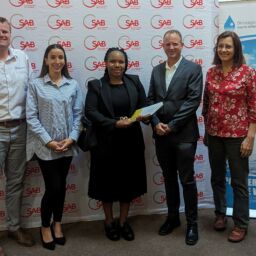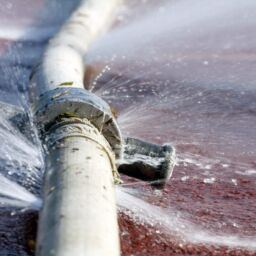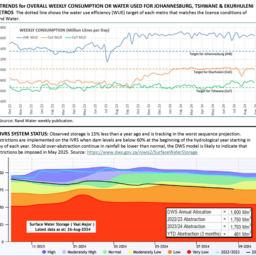
Johannesburg, 20 June 2024 – Are we sleepwalking towards a devastating water crisis that could cripple the economic heartland of South Africa? As industries grind to a halt, taps run dry, and over 13 million Gauteng residents face a future of dire water scarcity, it’s a scenario that appears closer than ever before.
Neglected infrastructure, ballooning demand, and mismanagement have pushed the province’s water supply to the brink. As Dr Sean Phillips, Director-General of the Department of Water and Sanitation, starkly stated, “We’re now in a situation where the demand for treated water in Gauteng is already occasionally exceeding the supply, particularly during peaks of demand.” The consequences of inaction could be catastrophic.
Yet this impending disaster has been years in the making. “The main reason why there isn’t enough water in the integrated Vaal River system is not because of a drought. It’s because there’s been increasing demand, particularly in the Gauteng municipalities due to rapid population growth,” Phillips explained. Compounding the problem are the staggering water losses, with Johannesburg Water’s physical losses at 25% and non-revenue water (NRW) at 48%. NRW also includes poor billing and revenue collection, not just leaks and theft.
As Salome Chiloane-Nwabueze, Head of Integration, Monitoring and Evaluation at Rand Water, emphasised, “We are losing more than 40% of our water that we are distributing to our customers.” The stark reality is that despite Rand Water’s 1.6 billion cubic metre allocation from the Department being woefully inadequate to meet galloping demand, the utility is already over-abstracting this constrained supply. Municipalities must have efficient revenue collection systems and reduce non-revenue water losses, or they won’t be able to pay Rand Water for the water provided.
The situation has become so dire that Rand Water recently sounded the alarm to Johannesburg, Tshwane, and Ekurhuleni that “the water supply system is on the verge of collapse.” As reservoirs drained during disruptions like load shedding, residents suffered prolonged outages lasting weeks as utilities struggled to refill depleted reserves against overwhelming demand.
Nandha Govender, General Manager at Eskom, underscored the severity, noting, “We are part of an integrated system. We cannot act as if we are not impacted.” With water being the lifeblood of electricity generation, a major supply crunch could have catastrophic knock-on effects throughout the economy. The impact of power outages on water pumping, treatment and distribution exacerbates the supply challenges.
Clearly, a multi-pronged approach is needed. As Phillips stated, “If we only do 2 out of the 4 or 5 things. Then we’re still going to have a high risk of disruptions.” Solutions span accelerating critical bulk infrastructure projects like Lesotho Highlands Water Project Phase 2, reducing staggering municipal water losses, and crucially, drastically curbing residential consumption, which at 250 litres per capita per day, far exceeds the international average of 170 litres per capita per day.
With over R70 billion in bulk water infrastructure investments underway through public-private partnerships, the race is on to boost supply. However, reducing non-revenue water at the municipal level is key to financial sustainability throughout the value chain, as Phillips emphasised. Peter Varndell, Executive Secretary of the Strategic Water Partners Network (SWPN) and CEO of the NEPAD Business Foundation which hosts the SWPN, noted the SWPN has supported initiatives at municipalities like Polokwane to implement non-revenue water reduction strategies and projects leveraging business contributions.
Govender advocated promoting better-integrated planning and water stewardship through expert collaboration and partnerships across sectors, adopting lessons from successful water conservation and water demand management programs, and exploring decentralised options like rainwater harvesting and groundwater use. Varndell stressed the need for transparency around data and analytics to guide targeted interventions at bulk, municipal, industrial and household levels based on their respective impacts.
The time for action is now. As Chiloane-Nwabueze stated, “It is not just the responsibility of water boards or municipalities or the Department – it becomes the responsibility of each and every individual to ensure water is consumed wisely for sustainability.” Varndell echoed this, calling for the SWPN’s partners to serve as advocates and leaders, helping to amplify awareness and drive collective action.
Addressing Gauteng’s water supply issues will require a concerted, multi-stakeholder effort. While the situation is concerning, there are potential solutions if all parties collaborate and take decisive action. Municipalities must improve revenue collection and reduce non-revenue water losses. Residents need to curb excessive consumption. Government and the private sector should accelerate infrastructure projects and promote integrated planning and conservation measures. With transparency, data-driven interventions, and a shared commitment to sustainable water management, it is possible to avoid disruptions to vital water services and economic activities in the province. However, delays will only exacerbate the challenges. Proactive steps need to be taken urgently by all stakeholders.
For a detailed synopsis of the meeting discussion, read this piece, compiled by Martin Ginster.
To view the presentation made by Rand Water, go here: Addressing Gauteng Water Supply Presentation June 2024 – Rand Water.
For further information about this webinar or to be added to our database for future events, please contact the SWPN Secretariat at swpn.secretariat@thenbf.co.za.











